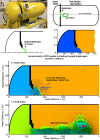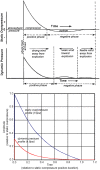Characterization of the Jet-Flow Overpressure Model of Traumatic Brain Injury in Mice
- PMID: 33748810
- PMCID: PMC7962691
- DOI: 10.1089/neur.2020.0020
Characterization of the Jet-Flow Overpressure Model of Traumatic Brain Injury in Mice
Abstract
The jet-flow overpressure chamber (OPC) has been previously reported as a model of blast-mediated traumatic brain injury (bTBI). However, rigorous characterization of the features of this injury apparatus shows that it fails to recapitulate exposure to an isolated blast wave. Through combined experimental and computational modeling analysis of gas-dynamic flow conditions, we show here that the jet-flow OPC produces a collimated high-speed jet flow with extreme dynamic pressure that delivers a severe compressive impulse. Variable rupture dynamics of the diaphragm through which the jet flow originates also generate a weak and infrequent shock front. In addition, there is a component of acceleration-deceleration injury to the head as it is agitated in the headrest. Although not a faithful model of free-field blast exposure, the jet-flow OPC produces a complex multi-modal model of TBI that can be useful in laboratory investigation of putative TBI therapies and fundamental neurophysiological processes after brain injury.
Keywords: blast; jet flow; multi-modal traumatic brain injury; overpressure chamber.
© Min-Kyoo Shin et al., 2021; Published by Mary Ann Liebert, Inc.
Conflict of interest statement
No competing financial interests exist.
Figures










Similar articles
-
Shock Wave Physics as Related to Primary Non-Impact Blast-Induced Traumatic Brain Injury.Mil Med. 2021 Jan 25;186(Suppl 1):601-609. doi: 10.1093/milmed/usaa290. Mil Med. 2021. PMID: 33499439
-
Significant head accelerations can influence immediate neurological impairments in a murine model of blast-induced traumatic brain injury.J Biomech Eng. 2014 Sep;136(9):091004. doi: 10.1115/1.4027873. J Biomech Eng. 2014. PMID: 24950710
-
Assessment of Compression Driven Shock Tube Designs in Replicating Free-Field Blast Conditions for Traumatic Brain Injury Studies.J Neurotrauma. 2021 Jun 15;38(12):1717-1729. doi: 10.1089/neu.2020.7394. Epub 2021 Jan 15. J Neurotrauma. 2021. PMID: 33108952
-
Brain injuries from blast.Ann Biomed Eng. 2012 Jan;40(1):185-202. doi: 10.1007/s10439-011-0424-0. Epub 2011 Oct 20. Ann Biomed Eng. 2012. PMID: 22012085 Review.
-
Working toward exposure thresholds for blast-induced traumatic brain injury: thoracic and acceleration mechanisms.Neuroimage. 2011 Jan;54 Suppl 1:S55-61. doi: 10.1016/j.neuroimage.2010.05.025. Epub 2010 May 17. Neuroimage. 2011. PMID: 20483376 Review.
Cited by
-
Reducing acetylated tau is neuroprotective in brain injury.Cell. 2021 May 13;184(10):2715-2732.e23. doi: 10.1016/j.cell.2021.03.032. Epub 2021 Apr 13. Cell. 2021. PMID: 33852912 Free PMC article.
-
From imaging to intervention: emerging potential of PET biomarkers to shape therapeutic strategies for TBI-induced neurodegeneration.Front Neurol. 2025 Aug 5;16:1637243. doi: 10.3389/fneur.2025.1637243. eCollection 2025. Front Neurol. 2025. PMID: 40837059 Free PMC article. Review.
-
Acutely blocking excessive mitochondrial fission prevents chronic neurodegeneration after traumatic brain injury.Cell Rep Med. 2024 Sep 17;5(9):101715. doi: 10.1016/j.xcrm.2024.101715. Epub 2024 Sep 5. Cell Rep Med. 2024. PMID: 39241772 Free PMC article.
-
Longitudinal in vivo monitoring of axonal degeneration after brain injury.Cell Rep Methods. 2023 May 16;3(5):100481. doi: 10.1016/j.crmeth.2023.100481. eCollection 2023 May 22. Cell Rep Methods. 2023. PMID: 37323578 Free PMC article.
-
Inhibiting 15-PGDH blocks blood-brain barrier deterioration and protects mice from Alzheimer's disease and traumatic brain injury.Proc Natl Acad Sci U S A. 2025 May 27;122(21):e2417224122. doi: 10.1073/pnas.2417224122. Epub 2025 May 21. Proc Natl Acad Sci U S A. 2025. PMID: 40397680 Free PMC article.
References
-
- Masel, B.E., and DeWirr, D.S. (2010). Traumatic brain injury: a disease process, not an event. J. Neurotrauma 27, 1529–1540 - PubMed
-
- Vincent, A.S., Roebuck-Spencer, T.M., and Cernich, A. (2014). Cognitive changes and dementia risk after traumatic brain injury: implications for aging military personnel. Alzheimers Dement. 10 (3 Suppl.), S174–S187 - PubMed
LinkOut - more resources
Full Text Sources
Other Literature Sources
Research Materials
